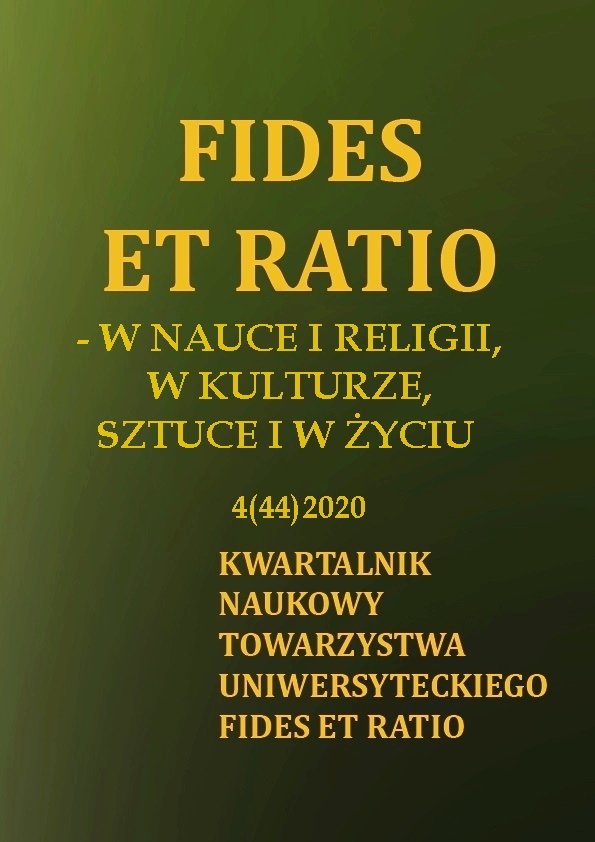Abstract
The article presents the psychometric properties of the Polish version of the Environmental Identity Scale (EID Scale) developed by Clayton (2003). The survey was conducted in the sample (N = 212) among adults aged 18–63. The convergent and divergent validity were assessed on the basis of the correlation between the EID Scale with the scale of rumination about self and the rumination about the social world (Rumination Questionnaire), the personality traits of the Big Five model (Ten Item Personality Inventory), the sense of safety (Safety Experience Questionnaire) and the materialistic values (Material Values Scale). The one-factor structure of the EID Scale was confirmed. The parameters of model fit took the next values: RMSEA (0,037; 90%CI: 0,024; 0,048), GFI (0,959), CFI (0,983), TLI (0,981), SRMR (0,079), χ2/df (324,815/252 = 1,29). The reliability of the Polish version of the EID Scale was high (Cronbach's alpha coefficient α was 0,91). The Polish version of the EID Scale has very good psychometric properties. The use of the EID Scale creates new opportunities in the development of environmental psychology in Poland.
References
Barrera-Hernández, L.F., Sotelo-Castillo, M.A., Echeverría-Castro, S.B., Tapia-Fonllem, C.O. (2020). Connectedness to Nature: Its Impact on Sustainable Behaviors and Happiness in Children, Frontiers in Psychology, 11, 276, https://doi.org/10.3389/fpsyg.2020.00276.
Baryła, W., Wojciszke, W. (2005). Kwestionariusz Ruminacji, Studia Psychologiczne, 43, 5–22.
Bedyńska, S., Książek, M. (2012). Statystyczny drogowskaz 3. Praktyczny przewodnik wykorzystania modeli regresji oraz równań strukturalnych, Warszawa: Wydawnictwo Akademickie Sedno.
Capaldi, C.A., Dopko, R.L., Zelenski, J.M. (2014). The relationship between nature connectedness and happiness: a meta-analysis, Frontiers in Psychology, 5, 976, https://doi.org/10.3389/fpsyg.2014.00976.
Clayton, S. (2003). Environmental Identity: A Conceptual and an Operational Definition, (w:) S. Clayton, S. Opotow (red.), Identity and the natural environment: The psychological significance of nature, 45–65, Cambridge: MIT Press.
Clayton, S., Irkhin, B., Nartova-Bochaver, S. (2019). Environmental Identity in Russia: Validation and Relationship to the Concern for People and Plants, Psychology. Journal of the Higher School of Economics, 16 (1), 85–107, https://doi.org/10.17323/1813-8918-2019-1-85-107.
Crowe, J.L. (2013). Transforming Environmental Attitudes and Behaviours through Eco-spirituality and Religion, International Electronic Journal of Environmental Education, 3 (1), 75–88.
Davis, J.L., Green, J.D., Reed, A. (2009). Interdependence with the environment: Commitment, interconnectedness, and environmental behavior, Journal of Environmental Psychology, 29 (2), 173–180, https://doi.org/10.1016/j.jenvp.2008.11.001.
Dutcher, D.D., Finley, J.C., Luloff, A.E., Johnson, J.B. (2007). Connectivity With Nature as a Measure of Environmental Values, Environment and Behavior, 39 (4), 474–493, https://doi.org/10.1177/0013916506298794.
Freed, A., Wong, D. (2019). The Relationship between University Students’ Environmental Identity, Decision-Making Process, and Behavior, Journal of Sustainability Education, 20.
Fritsche, I., Häfner, K. (2012). The Malicious Effects of Existential Threat on Motivation to Protect the Natural Environment and the Role of Environmental Identity as a Moderator, Environment and Behavior, 44 (4), 570–590, https://doi.org/10.1177/0013916510397759.
Górnik-Durose, M. (2016). Polska adaptacja skali wartości materialnych (MVS) – właściwości psychometryczne wersji pełnej i wersji skróconych, Psychologia Ekonomiczna, 9, 5–21, https://doi.org/10.15678/PJOEP.2016.09.01.
Ilevbare, F.M., Idemudia, E. S., Atiola, S. (2019). Environmental Identity, Health Locus of Control, and Quality of Life in Oil-Producing Community, Environmental Quality Management, 28, 123–129, https://doi.org/10.1002/tqem.21580.
Irkhin, B. D. (2020). Who Benefits from Environmental Identity? Studying Environmental Identity and Mental Wellbeing in Russia, Psychology in Russia: State of the Art, 13 (3), 66–78, https://doi.org/10.11621/pir.2020.0305.
Jia, F., Soucie, K., Alisat, S., Curtin, D., Pratt, M. (2017). Are environmental issues moral issues? Moral identity in relation to protecting the natural world, Journal of Environmental Psychology, 52, 104–113, https://doi.org/10.1016/j.jenvp.2017.06.004.
Kals, E., Schumacher, D., Montada, L. (1999). Emotional Affinity toward Nature as a Motivational Basis to Protect Nature, Environment and Behavior, 31(2), 178–202, https://doi.org/10.1177/00139169921972056.
Klamut, R. (2019). Dwuczynnikowy model doświadczania bezpieczeństwa – założenia teoretyczne i empiryczna weryfikacja: Kwestionariusz Doświadczania Bezpieczeństwa (KDB), Polskie Forum Psychologiczne, 24 (3), 308–323, https://doi.org/10.14656/PFP20190303.
Korkmaz, S., Goksuluk, D., Zararsiz, G. (2014). MVN: An R Package for Assessing Multivariate Normality, The R Journal, 6 (2), 151–162, https://journal.r-project.org/archive/2014-2/korkmaz-goksuluk-zararsiz.pdf.
Markowitz, E.M., Goldberg, L.R., Ashton, M.C., Lee, K. (2012). Profiling the “Pro-Environmental Individual”: A Personality Perspective, Journal of Personality, 80 (1), 81–111, https://doi.org/10.1111/j.1467-6494.2011.00721.x.
Martin, C., Czellar, S. (2016). The extended Inclusion of Nature in Self scale, Journal of Environmental Psychology, 47, 181–194, https://doi.org/10.1016/j.jenvp.2016.05.006.
Mayer, F.S., Frantz, C. M. (2004). The connectedness to nature scale: A measure of individuals’ feeling in community with nature, Journal of Environmental Psychology, 24 (4), 503–515.
Nisbet, E. K., Zelenski, J. M. (2014). Nature Relatedness and Subjective Well-Being, (w:) A.C. Michalos (red.), Encyclopedia of Quality of Life and Well-Being Research, 4269-4276, Dordrecht: Springer, https://doi.org/10.1007/978-94-007-0753-5_3909.
Olivos, P., Aragonés, J.-I. (2011). Propiedades psicométricas de la Escala de Identidad Ambiental (EID), Psyecology, 2 (1), 15–24, https://doi.org/10.1174/217119711794394671.
Otto, S., Pensini, P. (2017). Nature-based environmental education of children: Environmental knowledge and connectedness to nature, together, are related to ecological behaviour, Global Environmental Change, 47, 88–94, https://doi.org/10.1016/j.gloenvcha.2017.09.009.
Richins, M. (2004). The Material Values Scale: Measurement Properties and Development of a Short Form, Journal of Consumer Research, 31 (1), 209–219, https://doi.org/10.1086/383436.
Rosseel, Y. (2012). lavaan: An R Package for Structural Equation Modeling, Journal of Statistical Software, 48 (2), 1–36. http://www.jstatsoft.org/v48/i02/.
Sachdeva, S. (2016). Religious Identity, Beliefs, and Views about Climate Change, (w:) Oxford Research Encyclopedia of Climate Science, Oxford: Oxford University Press, https://doi.org/10.1093/acrefore/9780190228620.013.335.
Sorokowska, A., Słowińska, A., Zbieg, A., Sorokowski, P. (2014). Polska adaptacja testu Ten Item Personality Inventory (TIPI) – TIPI-PL – wersja standardowa i internetowa, Wrocław: WrocLab.
Tam, K.-P. (2013). Concepts and measures related to connection to nature: Similarities and differences, Journal of Environmental Psychology, 34, 64–78, https://doi.org/10.1016/j.jenvp.2013.01.004.
Taylor, B. (2019). Religion and environmental behaviour (part one): World religions and the fate of the Earth, The Ecological Citizen, 3 (1), 71–76.
Zemo, K.H., Nigus, H. Y. (2020). Does religion promote pro-environmental behaviour? A cross-country investigation, Journal of Environmental Economics and Policy, 1–24, https://doi.org/10.1080/21606544.2020.1796820.
